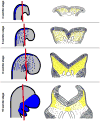Does the cranial mesenchyme contribute to neural fold elevation during neurulation?
- PMID: 22945385
- PMCID: PMC3473154
- DOI: 10.1002/bdra.23073
Does the cranial mesenchyme contribute to neural fold elevation during neurulation?
Abstract
The central nervous system is derived from the neural plate, which undergoes a series of complex morphogenetic events resulting in formation of the neural tube in a process known as neurulation. The cellular behaviors driving neurulation in the cranial region involve forces generated by the neural tissue itself as well as the surrounding epithelium and mesenchyme. Of interest, the cranial mesenchyme underlying the neural plate undergoes stereotypical rearrangements hypothesized to drive elevation of the neural folds. As the neural folds rise, the hyaluronate-rich extracellular matrix greatly expands resulting in increased space between individual cranial mesenchyme cells. Based on inhibitor studies, expansion of the extracellular matrix has been implicated in driving neural fold elevation; however, because the surrounding neural and epidermal ectoderm were also affected by inhibitor exposure, these studies are inconclusive. Similarly, treatment of neurulating embryos with teratogenic doses of retinoic acid results in altered organization of the cranial mesenchyme, but alterations in surrounding tissues are also observed. The strongest evidence for a critical role for the cranial mesenchyme in neural fold elevation comes from studies of genes expressed exclusively in the cranial mesenchyme that when mutated result in exencephaly associated with abnormal organization of the cranial mesenchyme. Twist is the best studied of these and is expressed in both the paraxial mesoderm and neural crest derived cranial mesenchyme. In this article, we review the evidence implicating the cranial mesenchyme in providing a driving force for neural fold elevation to evaluate whether there are sufficient data to support this hypothesis.
Copyright © 2012 Wiley Periodicals, Inc.
Figures


Similar articles
-
An explant assay for assessing cellular behavior of the cranial mesenchyme.J Vis Exp. 2013 Jan 20;(71):4245. doi: 10.3791/4245. J Vis Exp. 2013. PMID: 23381592 Free PMC article.
-
twist is required in head mesenchyme for cranial neural tube morphogenesis.Genes Dev. 1995 Mar 15;9(6):686-99. doi: 10.1101/gad.9.6.686. Genes Dev. 1995. PMID: 7729687
-
Hectd1 regulates intracellular localization and secretion of Hsp90 to control cellular behavior of the cranial mesenchyme.J Cell Biol. 2012 Mar 19;196(6):789-800. doi: 10.1083/jcb.201105101. J Cell Biol. 2012. PMID: 22431752 Free PMC article.
-
Stretching cell morphogenesis during late neurulation and mild neural tube defects.Dev Growth Differ. 2014 Aug;56(6):425-33. doi: 10.1111/dgd.12143. Epub 2014 May 29. Dev Growth Differ. 2014. PMID: 24888446 Review.
-
Neurulation in the cranial region--normal and abnormal.J Anat. 2005 Nov;207(5):623-35. doi: 10.1111/j.1469-7580.2005.00476.x. J Anat. 2005. PMID: 16313396 Free PMC article. Review.
Cited by
-
Insights into the Etiology of Mammalian Neural Tube Closure Defects from Developmental, Genetic and Evolutionary Studies.J Dev Biol. 2018 Aug 21;6(3):22. doi: 10.3390/jdb6030022. J Dev Biol. 2018. PMID: 30134561 Free PMC article. Review.
-
A single-cell atlas of spatial and temporal gene expression in the mouse cranial neural plate.bioRxiv [Preprint]. 2025 Mar 6:2024.08.25.609458. doi: 10.1101/2024.08.25.609458. bioRxiv. 2025. Update in: Elife. 2025 Apr 07;13:RP102819. doi: 10.7554/eLife.102819. PMID: 39229123 Free PMC article. Updated. Preprint.
-
Identification and functional analysis of rare HECTD1 missense variants in human neural tube defects.Hum Genet. 2024 Mar;143(3):263-277. doi: 10.1007/s00439-024-02647-4. Epub 2024 Mar 7. Hum Genet. 2024. PMID: 38451291 Free PMC article.
-
Neural tube closure: cellular, molecular and biomechanical mechanisms.Development. 2017 Feb 15;144(4):552-566. doi: 10.1242/dev.145904. Development. 2017. PMID: 28196803 Free PMC article. Review.
-
Identification and Functional Analysis of Rare HECTD1 Missense Variants in Human Neural Tube Defects.Res Sq [Preprint]. 2024 Jan 2:rs.3.rs-3794712. doi: 10.21203/rs.3.rs-3794712/v1. Res Sq. 2024. Update in: Hum Genet. 2024 Mar;143(3):263-277. doi: 10.1007/s00439-024-02647-4. PMID: 38260607 Free PMC article. Updated. Preprint.
References
-
- Ackermans MM, et al. Vitamin A and clefting: putative biological mechanisms. Nutr Rev. 2011;69:613–24. - PubMed
-
- Akiyama H, et al. Analytical studies on hyaluronic acid synthesis by normal human epidermal keratinocytes cultured in a serum-free medium. Biol Pharm Bull. 1994;17:361–4. - PubMed
-
- Beverdam A, Meijlink F. Expression patterns of group-I aristaless-related genes during craniofacial and limb development. Mech Dev. 2001;107:163–7. - PubMed
-
- Bildsoe H, et al. Requirement for Twist1 in frontonasal and skull vault development in the mouse embryo. Dev Biol. 2009;331:176–88. - PubMed
Publication types
MeSH terms
Substances
Grants and funding
LinkOut - more resources
Full Text Sources
Research Materials

